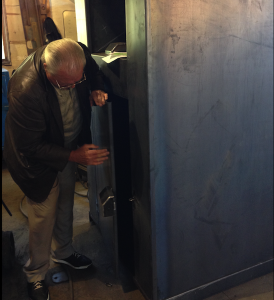

Our fundraising goal for 2020
 Textile Waste Diversion’s business model is geared to helping registered charities maximize fundraising potential through textile recycling. Our fiduciary obligation is to implement the most cost effective processes possible.
Textile Waste Diversion’s business model is geared to helping registered charities maximize fundraising potential through textile recycling. Our fiduciary obligation is to implement the most cost effective processes possible.
Up until recently, TWD sourced locally made wood bins but over time, we found lumber to be unsustainable. Aside from the forest burden, we found wood bins to be prone to weather damage, easy to steal, and in need of regular replacing. The maintenance of these bins on the long-term cost more than the initial higher costs of buying a more durable steel bin at the outset. With the readiness of recycled steel available, we felt it was the environmentally and fiscally responsible upgrade to make.
We found only a select few local suppliers of the fire resistant steel bins we to which we wanted to upgrade. It turned out that these steel bins were completely cost prohibitive and the manufacturers couldn’t guarantee the quantity we required. However, overseas, they were affordable, even with shipping factored in. The customer service offered was outstanding and the quality was great. We felt we had no other choice but to order overseas.
Part of our recently adopted Corporate Social Responsibility best practices initiative is to do what we can to maximize the local employment multiplication potential our company offered. That means supporting the local economy in every possible way including sourcing infrastructure. That was in direct conflict with our recent bin import contract.
We brought this dilemma to a family member, the Heritage Registry of Who’s Who in Business celebrated James Barton. He was once Thermos Canada’s Materials Manager.
His job was to coordinate shutting Thermos’s North American operation down and to facilitate their manufacturing operation being moved to China. After helping to restructure the organizations in Canada and the USA, the job was complete, and he too was restructured out at the age of 60, with no pension. When we told him we really wanted to bring our bin business home, he was determined to help us.
James told us that in this instant gratification world, we are used to punching a commodity into Google, and calling the first three suppliers we find. We assume big cities and big companies are better equipped to handle our needs, and are too eager to give up after the third “it can’t be done.”
He said sourcing locally can be done competitively if you are willing to put in the time and go into the project with an open mind. Less interested in a fancy website, and more interested in a plant’s machine inventory, James began vetting smaller rural steel manufacturers. He knew that small rural firms have less overhead, less red-tape and therefore can be far more flexible than top-heavy conglomerates.
We knew he was right because in the textile industry, it was mostly big giants that failed in the recession. The textile manufacturers that survived were smaller firms savvy enough to find a niche market they could survive on.
He found JSW Manufacturing in Bracebridge, Ontario. Founded by two best friends who had both been laid off from their job 19 years ago, and so they started their own firm with five employees and now employ just over 20 people. They have an impressive safety program as well as waste reduction machinery. Although they didn’t make the precise product we wanted, they did make other industrial/recycling containers so we knew they could handle it.
We sat down with co-owner Steve and his team, and together discussed our needs and budget. JSW was able to design an exclusive product that not only met all our requirements, like using recycled material, but was actually more competitive than our imported bins!
We are happy to announce that our infrastructure upgrade will now be mostly serviced locally, and that’s just the beginning!
Mr. Barton proved that sourcing local infrastructure can be done competitively. It might take a few more phone calls and a couple of long drives, but finding competitive local sourcing is possible if you are flexible and committed.
Bringing the business home does not really impact our bottom line much but the satisfaction we got knowing we brought this manufacturing business back to Ontario felt like a million bucks.